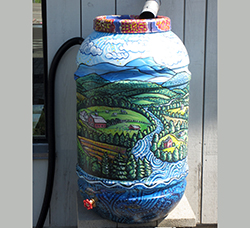Slow the Flow and Help the Lake with Rain Barrels
 by Executive Director Chris Boget
by Executive Director Chris Boget
Spring rains are a fact of life in the Northeast, but there are ways to reduce the potential for deluge-caused ditches and washouts. Rain barrels are a great way to capture and reuse the water flowing off your roof, protect your basement from flooding, and help safeguard the water quality of Lake Champlain.
You may have heard the term, but what exactly is a rain barrel? These large containers (usually 50 to 55 gallons in size) collect and store rainwater that flows off your roof. Many folks are surprised to learn that a one inch rainfall on a 2,000 square foot roof can generate 1,200 gallons of water! Rather than flushing rainwater directly onto the ground at high speeds, rain barrels intercept stormwater exiting your gutters, slowing and reducing flows off your property. This helps prevent excess sediments and pollutants from entering local waterways.
In addition to water quality improvements, rain barrels can save you time and money. Rain barrels provide homeowners with a ready source of water for gardening and lawn care, lowering your water bill and reducing wear and tear on private well systems. Rain barrels also help keep water away from basement walls, reducing the need for expensive pumping and other repairs after heavy rains.
When it comes to rain barrels, you have a few options. First off, keep in mind that your roof must have gutters in order use a rain barrel, and you’ll need to disconnect a downspout. Next, decide whether you want to purchase or build your own rain barrel. If you enjoy do-it-yourself projects, you will likely find constructing a rain barrel to be a relatively easy and straightforward project. Of course, if you’re not interested in making your own or don’t have the time, you can purchase rain barrels at most local garden centers and hardware stores.
For those constructing a rain barrel from scratch, there are a few things to keep in mind. You’ll need a reusable 50 or 55-gallon food-grade plastic barrel with a lid. Some good sources for barrels include food and beverage distributors, local breweries, and recycling centers. The tools required include a hacksaw, jigsaw, and power drill. As for parts, you’ll need a faucet, hose and a few plumbing connectors, which can be purchased separately or together in prepackaged do-it-yourself kits available at some hardware stores.
Homeowners ready to jump into rain barrel construction can view several step-by-step guides published online, including many with helpful photographs. A good place to start is the “Stormwater Solutions” section of the Let It Rain website, which includes rain barrel assembly instructions, as well as a brief tutorial on disconnecting a gutter downspout. Let It Rain is a stormwater program administered by Lake Champlain Sea Grant and the Winooski Natural Resources Conservation District.
Once you have your rain barrel in hand, you’ll want to think about proper siting. Many homeowners choose a downspout location near a garden, flower bed, or other area that requires watering during the warmer months. Others choose to place rain barrels next to the wet corner in the basement, or next to a large impervious surface like a paved driveway or patio to help reduce washouts and pooling of rainwater.
Rain barrels are a great way to protect your property, save money, and reduce the impact of stormwater on our waterways. To learn more about how you can help improve water quality, please contact us at .

